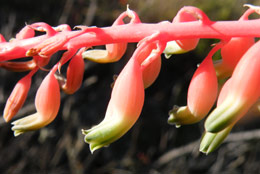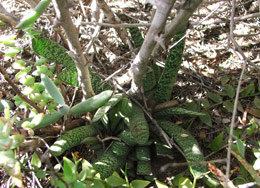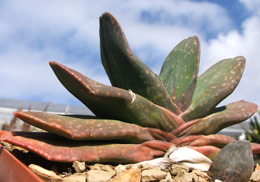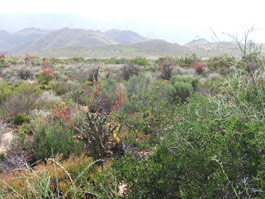Gasteria disticha
Gasteria disticha (L.) Haw.
Family: Asphodelaceae
Common names: Great Karoo ox-tongue (Eng.); grootkaroo-beestong, boesmanrys (Afr.)
Introduction
Gasteria disticha is a small aloe-like, succulent-leaved plant with leaves in two opposite rows and an elongated raceme with pinkish flowers, endemic to the flats and hills from Worcester to southeast of Robertson and the western Great Karoo (Western Cape Province). It is attractive and thrives in cultivation.

Description
Description
Plants acaulescent, ascending to erect, 25-180 (-230) mm in height and 75-180 (-230) mm in diameter, proliferating from the base to form small groups. Roots succulent, up to 5 mm in diameter. Leaves in two opposite rows (distichous), 60-120 (-170) mm long and 30-45 mm broad at the base, belt-shaped (lorate), ascending (rarely recurved), the leaf tips becoming incurved during the dry season. Upper surface plane to rounded, becoming channelled during the dry season; both surfaces with dense white spots arranged in irregular transverse bands; the surface (epidermis) like fine sandpaper (asperulous), the margin irregularly undulating, beset with whitish fine rounded bony teeth; the leaf ends are blunt (obtuse), rarely truncate, and with a distinct firm sharp point (mucronate). The juvenile leaves often spreading or recurved, with a blunt point.

Inflorescence racemose, simple, or with a pair of side branches, 200-900 mm tall, bearing 150-180 hanging flowers on upper half; floral bracts 7 mm long, 2 mm broad at the base. The flower stalks (pedicels) 5-7 mm long. The flowers (perianth) tubular, 12-20 mm long, swollen at the base, the tube 3-4 mm in diameter; pink to reddish-pink. Fruiting capsule oblong, 15-23 mm long, 7 mm broad. Seeds 3-4 mm long, 2-3 mm wide.

Flowering period: July-February, but mainly in September.
Gasteria disticha is closely related to G. brachyphylla which grows in the Klein Karoo and has a smooth leaf surface. Although both have leaves in opposite rows, G. disticha is immediately recognized by its rough leaf texture (almost like fine sandpaper).
Three varieties of G. disticha are recognized (Van Jaarsveld 2007):
The typical variety (var. disticha ) has leaves 60-120 x 30-45 mm, often undulating and with a wrinkled margin. It grows mainly in the Breede River Valley in Robertson Karoo and in the Koedoesberge-Moordenaarskaroo (Rainshadow Valley Karoo Bioregion) in Succulent Karoo vegetation.
Gasteria disticha var. langebergensis is immediately distinguished from var. disticha by its smaller, narrow leaves with distinctly toothed (denticulate) margins. This variety is endemic to the lower southern slopes of the Langeberg (mainly on shale and dolomite) near the Langvlei Quarry between Worcester and Robertson. Plants grow on rock outcrops in the shade of karoo shrubs. The variety was first collected by Bruce Bayer, former Curator of the Karoo National Botanical Garden.

Gasteria disticha var. langebergensis in its natural habitatnear the Langvlei Quarry (Robertson, Western Cape)
Gasteria disticha var. robusta is distinguished from G. disticha var. disticha by its firm, shorter, robust leaves 55-100 × 45-65 mm and its flowering time during midsummer. The plants grow in Gamka Karoo (Nama-Karoo) vegetation in the Beaufort West and Merweville regions, with mostly summer rain.

Conservation Status
Status
Gasteria disticha in the southern part of its distribution (Robertson Karoo) range is vulnerable, occurring in a popular wine farming region. Although its status has been determined as critically endangered (Raimondo et al. 2009), this pertains only to G. disticha var. langebergensis as its habitat is threatened by mining. The other varieties are widespread and still fairly common. Although it is well camouflaged and difficult to find, some populations (var. disticha) are threatened by bush clearing and ploughing. The plant has been well established in cultivation (ex situ preservation) and is grown by succulent plant enthusiasts all over the world.
Distribution and habitat
Distribution description
Gasteria disticha is widely distributed in the southern parts of the Great Karoo below the Great Escarpment, from Beaufort West in the north to the Swartberg mountain range in the south and as far east as Rietbron; to the west it just enters the Tanqua Karoo. It is also widely distributed in the Breede River Valley from Worcester to Drew, the Koo Valley and Ouberg Pass in the Montagu District. It is found at elevations up to 800 m (Robertson Karoo) in Succulent Karoo and Nama Karoo (Mucina & Rutherford 2006). It grows in the shade of karoo shrubs on rocky outcrops on rock formations of tillite, sandstone, mudstone and shale. The soils are minerally rich and well drained with a pH of between 4.9 and 7.6. Rainfall, ranging from 100-300 mm per annum, occurs in winter and summer. In the southwest there is a tendency to summer dryness but towards Beaufort West, the reverse is true. Temperatures are very hot in summer and moderate in winter but frost may be experienced, especially in the northern parts.

Derivation of name and historical aspects
History
G. disticha was one of the first species to have reached Europe. It was collected by Hendrik Oldenland in 1689 east of Cape Town on the Isak Schrijver expedition (Wijnands 1983). Oldenland named the plant between 1688 and 1697 in his "Kruid Boek", or local herbarium, under the long phrase name Aloe africana flore rubro folia maculis ab utraque parte albicantibus notata. In 1753, Carl Linnaeus (the Swedish botanist) introduced his binomial naming system (with species names consisting of two entities: the genus name and the specific epithet) in his well known Species Plantarum, when the old phrase name system was finally abolished. He then named the plant Aloe disticha. However, the succulent student Adrian Haworth rightly transferred it to the genus Gasteria in 1827. The specific epithet "disticha" pertains to the arrangement of its leaves which is in two opposite rows. The genus Gasteria is closely related to the genus Aloe but differs by the pendent (nodding) flower stalks and brittle leaves which are not bitter and which root when fallen to the ground.
Ecology
Ecology
Gasteria disticha grows in the shade of spiny karoo shrubs such as Carissa haematocarpa, often in rocky soil. The mottled greenish leaves are well camouflaged among the vegetation. During drought the leaves become reddish brown tanned and blend in with the natural surroundings. The flowers usually protrude above the shrubs where they are pollinated by sunbirds. Seeds ripen during summer. The capsules, when ripe, are held in an erect position and seeds are released by strong gusts of wind and are wind-dispersed. Like many other Gasteria species its leaves are brittle and will proliferate when fallen on the ground. The succulent leaves and roots enable the plant to cope with the dry season and general dry conditions. Gasteria disticha and most other Gasteria species have a vegetative propagation back-up. They are often eaten by animals. When leaf fragments drop to the ground after being eaten, they root and the portions sprout new offsets.
Uses
Use
In the Robertson District its flowers, locally known as oukossie, are harvested during spring. They are cooked up in a meaty stew and eaten. Plants are occasionally cultivated on rockeries or in containers.
Growing Gasteria disticha
Grow
Gasteria disticha thrives in cultivation and does best as a pot plant or grown in rockeries in a Succulent Karoo or Nama Karoo garden (Van Jaarsveld 2010). It is a slow grower. In other parts of the world it can also be grown out-of-doors, but is best cultivated in dry Mediterranean-type gardens where frost is not too severe (parts of California and the Mediterranean). Although it can be grown in full sun, plants prefer some slight shade, and in hot climates should therefore be protected from full sun. Plants should reach flowering size in about 4 years.
Propagation
Gasteria disticha is easily propagated from seed or by division or leaf cuttings. It is best to apply a fungicide when grown from seed. Sow seed during spring or summer in a warm, shady position in a sandy slightly acidic soil and keep moist. Cover with a thin layer of sand and keep moist. Germination is usually within 3 weeks. Seedlings grow slowly and are best planted out about a year after sowing. Propagation from leaf cuttings is best undertaken in spring. Allow the leaf cutting to form a heel by placing it on a dry window sill for a week or three. Cuttings are best rooted in clean sand. Once rooted, plants can be planted into individual containers. Plants react well to organic feeding (compost or any other liquid fertilizer). Gasteria disticha is best watered throughout the year.
References
- Gunn, M. & Codd, L.E. Botanical exploration of southern Africa. A.A. Balkema, Cape Town.
- Mucina, L. & Rutherford, M.C. (eds) 2006. The vegetation of South Africa, Lesotho and Swaziland. Strelitzia 19. South African National Biodiversity Institute, Pretoria.
- Raimondo, D., Von Staden, L., Foden, W.,Victor, J.E., Helme, N.A., Turner, R.C., Kamundi, D.A. & Manyama, P.A. (eds) 2009. Red List of South African plants 2009. Strelitzia 25. South African National Biodiversity Institute, Pretoria.
- Van Jaarsveld, E.J. 1994. Gasterias of South Africa. Fernwood Press.
- Van Jaarsveld, E.J. 2007. The genus Gasteria, a synoptic review. Aloe 44, 4: 84-103.
- Van Jaarsveld, E.J. 2010. Waterwise gardening in South Africa and Namibia. Struik, Cape Town.
- Wijnands, O. 1983. The Botany of the Commelins. Balkema, Rotterdam.
Credits
Ernst van Jaarsveld
Kirstenbosch National Botanical Garden
July 2012
Plant Attributes:
Plant Type: Succulent
SA Distribution: Western Cape
Soil type: Loam
Flowering season: Spring
PH: Acid, Neutral
Flower colour: Pink
Aspect: Full Sun, Shade, Morning Sun (Semi Shade)
Gardening skill: Challenging
Special Features:
Horticultural zones









Rate this article
Article well written and informative
Rate this plant
Is this an interesting plant?
Login to add your Comment
Back to topNot registered yet? Click here to register.